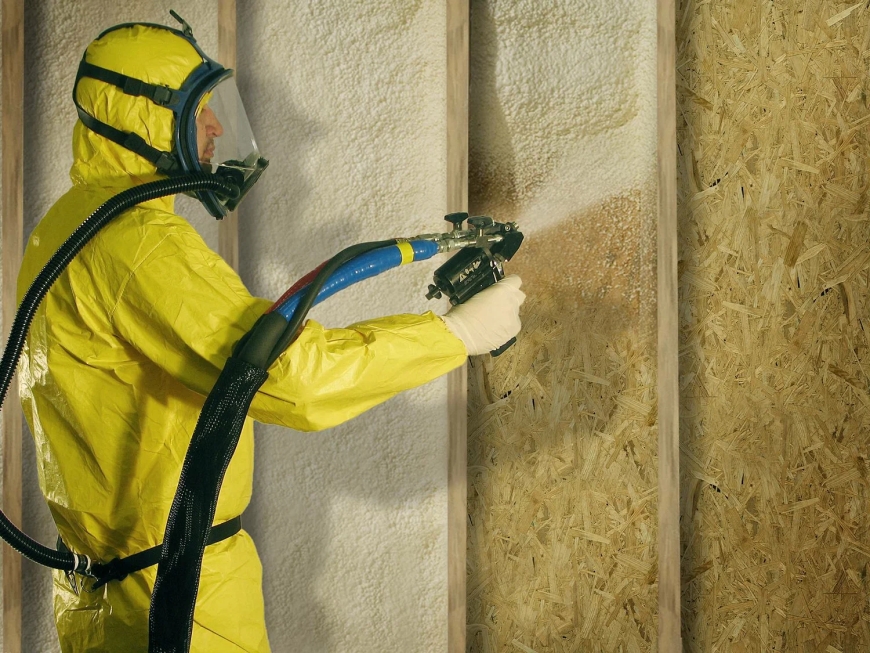How Spray Foam Keeps Your Home Comfortable Year-Round
This article offers a clear, research-based explanation of how it works, compares it to other insulation types, outlines technical data, and explains key factors to weigh before choosing it.

Spray foam keeps your home comfortable year-round by sealing gaps and insulating better than traditional materials, stabilizing indoor temperatures across all seasons. Whether it’s the dead of winter or the peak of summer, spray foam acts as both a thermal resistor and an air barrier. It prevents conditioned air from escaping and stops outside air from seeping in, making your home warmer in winter, cooler in summer, and far more energy-efficient every day.
Unlike fiberglass or cellulose, which only slow down conductive heat flow, spray foam controls both conduction and convection. It stops air leaks and heat transfer simultaneously, solving two problems at once–. This article offers a clear, research-based explanation of how it works, compares it to other insulation types, outlines technical data, and explains key factors to weigh before choosing it.
How Spray Foam Regulates Year-Round Comfort
At its core, expert spray foam insulation in homes ensures comfort by creating a sealed thermal envelope. It does this in two critical ways: by resisting heat transfer (via a high R-value) and by eliminating air leaks, which are the main source of energy loss in buildings.
Traditional insulation materials, like fiberglass batts or blown cellulose, become far less effective when air leaks are present. They allow warm or cold air to bypass insulation layers, rendering even high R-values ineffective. Spray foam, on the other hand, expands on contact—up to 100 times its liquid volume—filling even the smallest crevices, joints, and penetrations.
In winter, this sealed barrier keeps warm air in and cold drafts out, allowing for more stable indoor temperatures and fewer heating cycles. In summer, it prevents external heat and humidity from penetrating wall cavities and attic spaces, making it easier for your cooling system to keep interior temperatures low.
The result is a consistent indoor climate with minimal fluctuations—fewer hot and cold spots, less reliance on space heaters or fans, and lower energy bills due to reduced HVAC demand.
Comparison with Other Insulation Types
When evaluating spray foam’s comfort performance, its technical and functional differences stand out clearly when compared to traditional insulation.
|
Feature |
Spray Foam (Closed-Cell) |
Spray Foam (Open-Cell) |
Fiberglass Batt |
Cellulose |
|---|---|---|---|---|
|
R-Value per inch |
6.0–7.5 |
3.5–3.6 |
2.2–3.8 |
3.0–3.8 |
|
Air Seal |
Complete |
Complete |
Incomplete |
Partial |
|
Vapor Barrier |
Yes |
No |
No |
No |
|
Sound Dampening |
Moderate |
High |
Low |
Moderate |
|
Service Life |
30+ years |
25–30 years |
10–25 years |
20–30 years |
|
Best Use Case |
Exterior walls, basements |
Interior walls, attics |
Walls, ceilings |
Attics |
|
Cost |
High |
Moderate |
Low |
Moderate |
The most substantial differentiator is spray foam’s ability to eliminate air infiltration, a key contributor to heat loss and gain. Conventional insulation slows conductive heat but allows air to pass through. This shortcoming is critical: according to the U.S. Department of Energy, air leaks alone can account for 30–50% of total energy loss in a typical home.
In-Depth Technical Data
Understanding how spray foam achieves superior performance requires looking at its technical makeup and how it interacts with structural components.
|
Technical Parameter |
Closed-Cell Foam |
Open-Cell Foam |
|---|---|---|
|
R-Value (per inch) |
~6.5 |
~3.6 |
|
Density |
1.75–2.25 lb/ft³ |
0.4–0.6 lb/ft³ |
|
Structural Rigidity |
High (adds wall strength) |
Low |
|
Vapor Transmission |
<1 perm (vapor barrier) |
>10 perms (vapor permeable) |
|
Expansion Rate |
~1 inch thick per application |
Expands up to 3 inches |
|
Flame Retardant Additives |
Required by code |
Required by code |
|
Application Environment |
Below-grade, exterior, roofs |
Attics, interior partitions |
Closed-cell foam is particularly valuable in extreme climates or locations prone to high humidity. Its rigid structure not only insulates but reinforces structural elements, improving wall strength and moisture control. Open-cell foam, while less dense, excels at sound absorption and is often used in partition walls and ceilings.
Year-Round Performance Explained
Cold-Weather Benefits
In winter, comfort depends on retaining heated air while blocking cold outdoor drafts. Spray foam’s continuous air seal eliminates cold spots along window edges, rim joists, and attic hatches—areas where fiberglass and cellulose often underperform. Homes insulated with spray foam often maintain a 3–6°F more stable indoor temperature with fewer HVAC cycles.
Because closed-cell spray foam also acts as a vapor barrier, it reduces the risk of condensation inside walls, which can lead to mold or mildew over time. That benefit is critical in climates where warm interior air meets cold exterior surfaces.
Hot-Weather Performance
In warm months, comfort is all about keeping heat and humidity out. Spray foam does this by reducing solar heat gain in attic spaces and stopping warm, humid air from infiltrating through unsealed walls. In tests across southern U.S. climates, homes with attic spray foam showed attic temperatures up to 30°F cooler than those with standard fiberglass—directly translating to more efficient air conditioning.
The sealed nature of spray foam also restricts the flow of moisture-laden air. This reduces indoor humidity levels and helps prevent the growth of mold and allergens, which thrive in moist environments.
Things to Consider Before Making a Decision
Choosing spray foam requires evaluating both its advantages and potential trade-offs. It’s not a plug-and-play solution for every home.
Home Structure and Age Older homes may need additional prep work before spray foam is applied, such as removing old insulation, repairing joist gaps, or adjusting electrical routing. Walls with lathe and plaster may not accommodate foam injection without structural alteration.
Budgeting and ROI Spray foam costs 2–3 times more upfront than fiberglass or cellulose. However, the return on investment through reduced energy bills, extended HVAC life, and fewer comfort complaints can be realized in as little as 3–5 years in cold or mixed climates.
Compatibility with Building Systems Because spray foam makes homes airtight, ventilation systems must be adjusted accordingly. Mechanical ventilation (like HRVs or ERVs) is often needed to maintain indoor air quality. Poor planning here can lead to elevated CO2 levels or moisture buildup.
Fire Safety and Code Requirements Foam must be protected by a thermal barrier, such as drywall or a fire-rated coating. Some jurisdictions have additional fire-retardant standards, especially in multifamily units or near furnaces and water heaters.
Bonus Tip: In mixed climates, consider using open-cell foam in interior walls for sound control and closed-cell foam in basements and attics for moisture resistance and insulation.
Moisture and Sound Control
While thermal performance is spray foam’s standout feature, its secondary benefits shouldn’t be overlooked.
Moisture Management Spray foam reduces the risk of mold by limiting condensation and moisture intrusion. Closed-cell foam has a perm rating under 1, making it vapor-resistant. This is especially useful in basements or crawl spaces, where humidity often creates problems in traditional insulation setups.
Acoustic Dampening Open-cell foam is particularly effective at absorbing airborne noise such as voices, traffic, and appliance hum. Its spongy texture creates irregular pathways for sound waves, reducing sound transmission across rooms or floors.
In combination with thermal performance, these secondary advantages support a holistic approach to comfort—temperature, humidity, and acoustic consistency.
Common Questions
Does spray foam affect indoor air quality?
Once fully cured, spray foam is chemically inert and does not release harmful particles or vapors. Proper installation and curing time are key. Most off-gassing occurs during the first 24–48 hours, after which it is safe.
Will my HVAC system need adjustment?
Yes. Because your home becomes more airtight, HVAC systems may require recalibration. In some cases, downsizing HVAC capacity can also result in better efficiency and lower costs.
Can spray foam be used in unvented attics?
Absolutely. Spray foam is ideal for creating unvented attic assemblies. It prevents extreme attic temperatures, reducing strain on ductwork and improving overall home comfort.
Is there a risk of over-sealing my home?
Yes, which is why mechanical ventilation is often added. While airtight homes are more efficient, they must exchange stale indoor air with fresh outdoor air at controlled rates.
Make the Right Decision
Advanced Spray foam insulation solutions are one of the best options for homeowners looking to maintain year-round comfort, reduce energy use, and improve air quality. It functions as both a high-performance insulator and a comprehensive air sealant, outperforming traditional materials in most residential applications.
But it’s not a universal solution. Consider your climate, existing structure, ventilation strategy, and long-term energy goals. With proper planning, professional installation, and ventilation design, spray foam can transform your home into a consistent, comfortable environment—regardless of the season.
Reviewer: Olivia Thompson has spent 10 years working in spray foam insulation, helping companies grow their visibility. She reviewed this article and provided valuable suggestions on how to better align the content with the needs and expectations of customers, ensuring it resonates with the target audience.


























































































































































